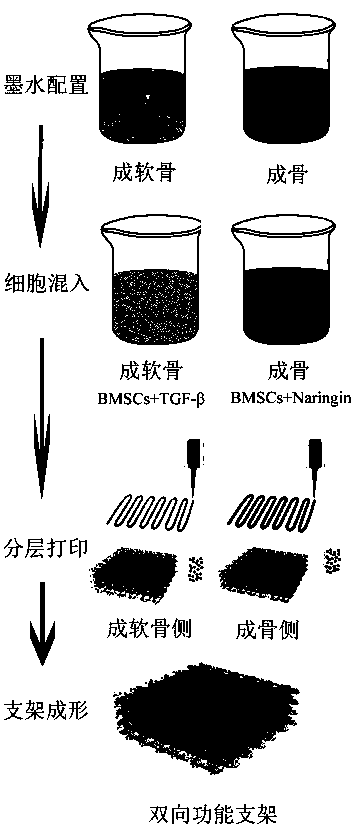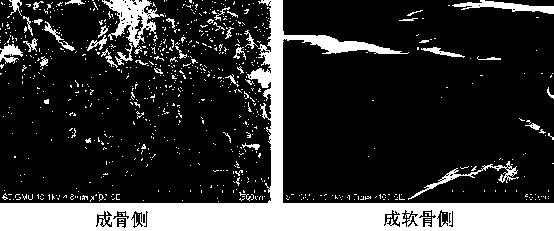Bone-cartilage bidirectional function bracket based on cell 3D printing, and preparation method thereof
A 3D printing and cartilage technology, applied in medical science, prosthesis, tissue regeneration, etc., can solve the problem of single function of the scaffold, achieve clear chemical structure, convenient purification, and beneficial to tissue regeneration
- Summary
- Abstract
- Description
- Claims
- Application Information
AI Technical Summary
Problems solved by technology
Method used
Image
Examples
Embodiment 1
[0038] A method for preparing a bone-cartilage bidirectional functional scaffold, comprising the steps of:
[0039] S1. Configure bone-forming ink matrix and chondrogenic ink matrix, and prepare them after disinfection; wherein, the bone-forming ink matrix includes the following mass percentages: 10% mesoporous bioglass powder, 5% sodium alginate, 5% gelatin, and the rest for water;
[0040]The chondrogenic ink matrix includes the following composition in mass percentage: 10% sodium alginate, 2.5% gelatin, and the balance is water.
[0041] S2. Add bone marrow mesenchymal stem cells (BMSCs) and naringin (Naringin) into the matrix of bone-forming ink to obtain bone-forming ink; in the bone-forming ink, the concentration of BMSCs is 5×10 6 / mL, the concentration of naringin is 1×10 -5 mol / L.
[0042] BMSCs and transforming growth factor β (TGF-β) (1 × 10 -9 mol / L) was added into the matrix of the chondrogenic ink to obtain the chondrogenic ink. In the chondrogenic ink, th...
Embodiment 2
[0047] A method for preparing a bone-cartilage bidirectional functional scaffold, comprising the steps of:
[0048] S1. Configure bone-forming ink matrix and chondrogenic ink matrix, and prepare them after disinfection; wherein, the bone-forming ink matrix includes the following components by mass percentage: 5% mesoporous bioglass powder, 10% sodium alginate, 2.5% gelatin, and the balance for water;
[0049] The chondrogenic ink matrix includes the following composition in mass percentage: 10% sodium alginate, 5% gelatin, and the balance is water.
[0050] S2. Add bone marrow mesenchymal stem cells (BMSCs) and naringin (Naringin) into the matrix of bone-forming ink to obtain bone-forming ink; in the bone-forming ink, the concentration of BMSCs is 5×10 6 / mL, the concentration of naringin is 1×10 -5 mol / L.
[0051] Add BMSCs and transforming growth factor β (TGF-β) into the matrix of chondrogenic ink to obtain chondrogenic ink. In the chondrogenic ink, the concentration ...
Embodiment 3
[0056] A method for preparing a bone-cartilage bidirectional functional scaffold, comprising the steps of:
[0057] S1. Configure bone-forming ink matrix and chondrogenic ink matrix, and prepare them after disinfection; wherein, the bone-forming ink matrix includes the following components by mass percentage: 5% mesoporous bioglass powder, 10% sodium alginate, 2.5% gelatin, and the balance for water;
[0058] The chondrogenic ink matrix includes the following composition in mass percentage: 10% sodium alginate, 5% gelatin, and the balance is water.
[0059] S2. Add bone marrow mesenchymal stem cells (BMSCs) and naringin (Naringin) into the matrix of bone-forming ink to obtain bone-forming ink; in the bone-forming ink, the concentration of BMSCs is 5×10 6 / mL, the concentration of naringin is 1×10 -4 mol / L.
[0060] Add BMSCs and transforming growth factor β (TGF-β) into the matrix of chondrogenic ink to obtain chondrogenic ink. In the chondrogenic ink, the concentration ...
PUM
| Property | Measurement | Unit |
|---|---|---|
| Concentration | aaaaa | aaaaa |
| Concentration | aaaaa | aaaaa |
Abstract
Description
Claims
Application Information
 Login to View More
Login to View More - R&D
- Intellectual Property
- Life Sciences
- Materials
- Tech Scout
- Unparalleled Data Quality
- Higher Quality Content
- 60% Fewer Hallucinations
Browse by: Latest US Patents, China's latest patents, Technical Efficacy Thesaurus, Application Domain, Technology Topic, Popular Technical Reports.
© 2025 PatSnap. All rights reserved.Legal|Privacy policy|Modern Slavery Act Transparency Statement|Sitemap|About US| Contact US: help@patsnap.com



